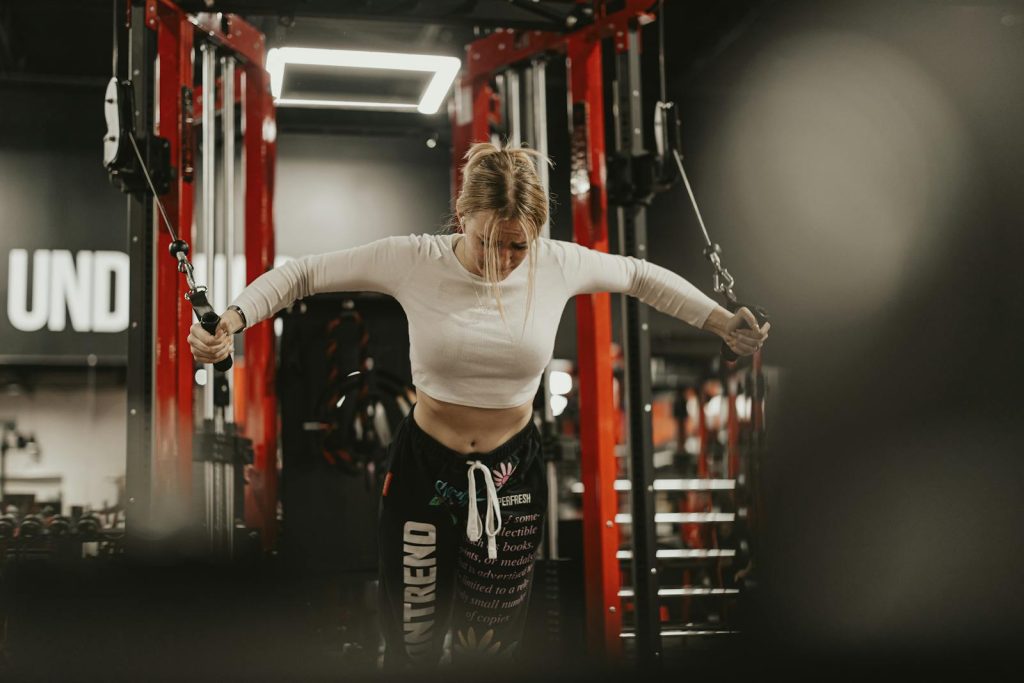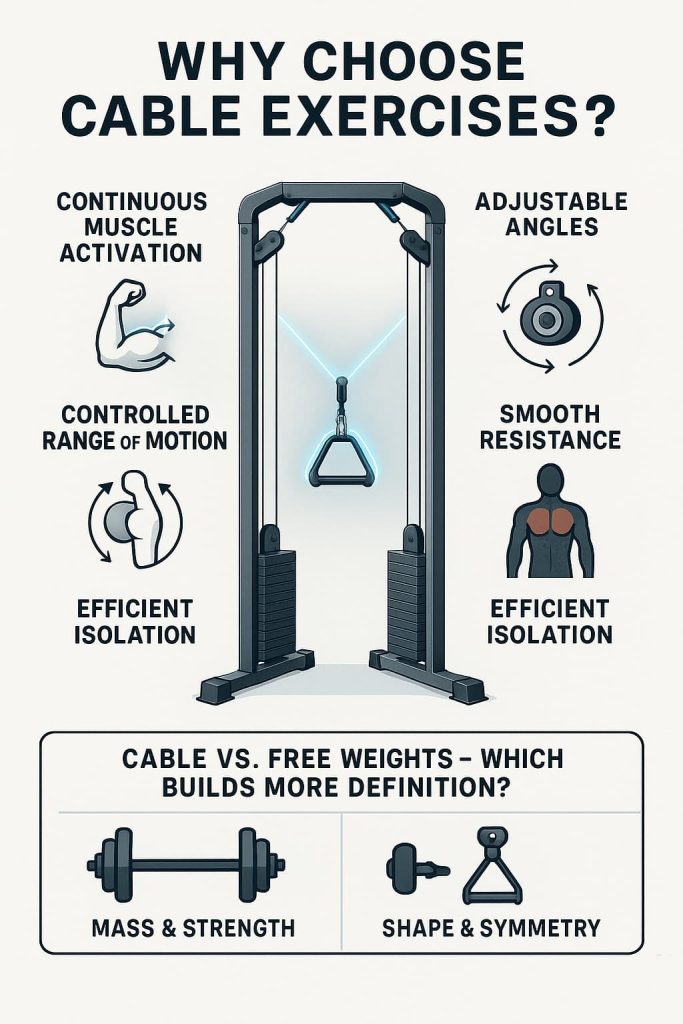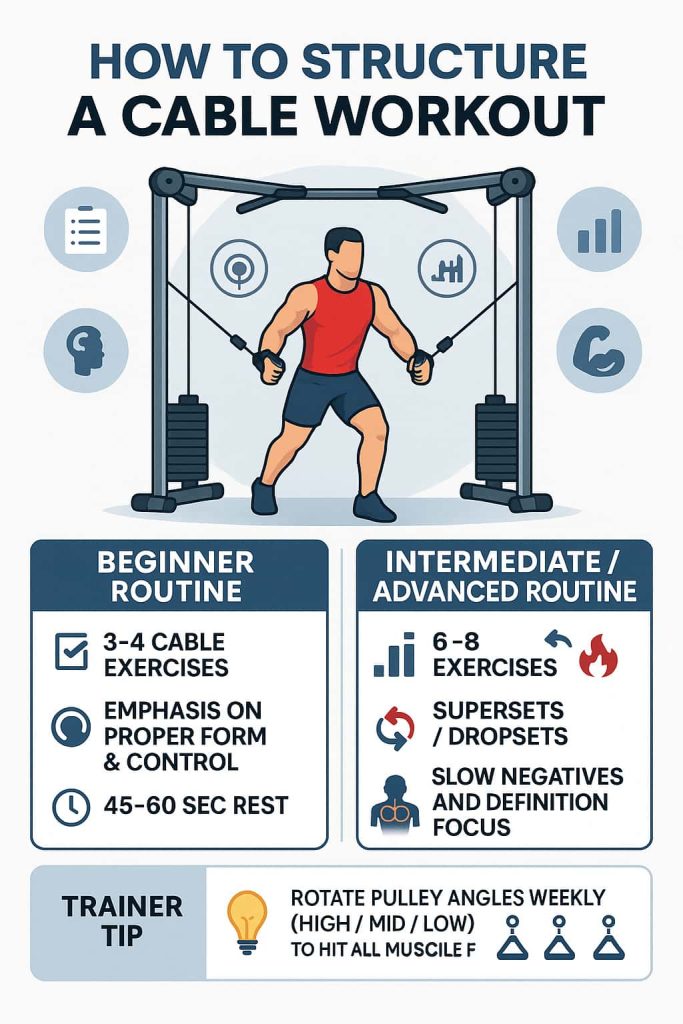Cable exercises are among the most effective ways to build muscle and definition because they provide constant tension throughout the movement.
Unlike free weights, cable machines maintain engagement from start to finish — boosting muscle growth, control, and safety.

Whether you’re training your chest, back, arms, or core, cables offer superior versatility and let you isolate specific muscle fibers with precision.
In this expert guide, we’ll break down the 13 best cable exercises for muscle growth and definition, explain how to structure your cable workouts, and reveal common mistakes to avoid for faster results.
Why Choose Cable Exercises?
Cables deliver constant tension, making them ideal for shaping, toning, and building lean muscle.
This consistent load improves strength while reducing joint stress, allowing you to safely perform isolation movements or supersets.

Benefits of Cable Workouts
- Continuous muscle activation for better hypertrophy
- Adjustable angles to hit every fiber of the target muscle
- Controlled range of motion reduces injury risk
- Smooth resistance ideal for beginners and pros alike
- Efficient isolation for symmetry and definition
Cable vs. Free Weights — Which Builds More Definition?
Free weights build mass and raw strength, but cables help carve out muscle shape and balance.
The best approach combines both — use free weights for compound lifts and cables for isolation and refinement.
How to Structure a Cable Workout
Cables can fit into almost any split — whether you’re following push/pull/legs or full-body training.
Here’s how to integrate them effectively:

Beginner Routine:
- 3–4 cable exercises per workout
- Focus on learning proper form and tension control
- Rest 45–60 seconds between sets
Intermediate/Advanced:
- 6–8 cable exercises
- Combine compound cable moves (rows, presses) with isolation work (flyes, curls)
- Use dropsets, supersets, or slow negatives for muscle definition
💡 Trainer Tip: Rotate pulley angles weekly (high/mid/low) to stimulate different muscle fibers and avoid adaptation.
13 Best Cable Exercises for Muscle and Definition
Each exercise includes: Primary muscles worked, why it’s effective, and pro tips for form and progress.
1. Cable Chest Fly (Standing or Incline)
Why it works:
Cable chest flies provide constant tension across the chest’s range of motion, unlike dumbbells where tension drops at the top. This continuous engagement maximizes muscle fiber recruitment and enhances inner and outer chest definition.
Muscles worked:
Pectoralis major, anterior deltoids, biceps (stabilization)
How to do it:
- Set pulleys slightly above shoulder height.
- Grab handles and step forward with one foot for balance.
- With a slight bend in your elbows, bring the handles together in a wide hugging motion until your hands meet in front of your chest.
- Slowly return to the starting position, maintaining control.
Trainer Tip:
Pause and squeeze at the midpoint for 1–2 seconds. Avoid letting the weights rest between reps to keep constant tension.
2️. Seated Cable Row
Why it works:
This move builds mid-back thickness by targeting the rhomboids and traps while improving posture and shoulder stability. Cables ensure even resistance throughout the pull.
Muscles worked:
Latissimus dorsi, trapezius, rhomboids, rear deltoids, biceps
How to do it:
- Sit on the machine with feet flat and knees slightly bent.
- Grab the V-handle and pull it toward your lower ribcage.
- Keep your back straight and shoulders pulled back.
- Control the return without leaning too far forward.
Trainer Tip:
Think “elbows to hips,” not “hands to chest.” This ensures proper lat engagement.
3️. Cable Lat Pulldown (Wide Grip)
Why it works:
The wide-grip variation isolates the outer lats, enhancing the V-taper shape while strengthening the upper back.
Muscles worked:
Latissimus dorsi, biceps brachii, teres major, traps
How to do it:
- Sit down, secure your thighs under the pads, and grab the bar wider than shoulder-width.
- Pull the bar down to your upper chest while keeping your chest up.
- Pause briefly and slowly return to the start.
Trainer Tip:
Avoid pulling behind the neck — it increases shoulder strain. Keep your spine neutral and core tight.
4️. Cable Crossover (Low to High)
Why it works:
Lifting from low to high targets the upper chest fibers, adding height and fullness to the pecs for a more balanced chest aesthetic.
Muscles worked:
Upper pectoralis major, front deltoids
How to do it:
- Set cables to the lowest setting.
- With a handle in each hand, take a staggered stance.
- Bring handles upward and together in front of your upper chest, forming an “X.”
- Slowly return to start.
Trainer Tip:
Keep your torso still and elbows slightly bent — focus on squeezing the upper chest at the top.
5️. Cable Shoulder Lateral Raise
Why it works:
Cables keep tension constant through the entire arc of motion, shaping round, defined shoulders and improving shoulder symmetry.
Muscles worked:
Lateral deltoids, supraspinatus (assist)
How to do it:
- Attach a single handle at the lowest setting.
- Stand sideways to the machine and grab the handle with your far hand.
- With a slight bend in your elbow, raise your arm out to shoulder height.
- Lower slowly under control.
Trainer Tip:
Lean slightly away from the pulley to increase range and stretch at the bottom.
6️. Cable Face Pull
Why it works:
Face pulls correct muscular imbalances caused by excessive pressing. They strengthen the rear delts and rotator cuff — critical for posture and shoulder health.
Muscles worked:
Rear deltoids, traps, rhomboids, rotator cuff
How to do it:
- Set a rope attachment at upper-chest height.
- Grab both ends with palms facing inward.
- Pull the rope toward your forehead while flaring elbows outward.
- Squeeze shoulder blades together at the end.
Trainer Tip:
Perform slow, controlled reps. Add this move to every push-pull day to prevent rounded shoulders.
7️. Cable Bicep Curl (Rope or Bar Attachment)
Why it works:
Cables offer continuous resistance that maximizes the biceps’ time under tension, encouraging full muscle engagement and better shape.
Muscles worked:
Biceps brachii, brachialis, brachioradialis
How to do it:
- Attach a straight or EZ bar to the low pulley.
- Stand tall, elbows close to your torso.
- Curl the bar toward your shoulders, keeping wrists straight.
- Lower slowly to full extension.
Trainer Tip:
Avoid swinging. Use slow 3-second negatives for optimal growth and definition.
8️. Cable Triceps Pushdown
Why it works:
This isolates the triceps through their full contraction range, building arm thickness and improving lockout strength in presses.
Muscles worked:
Triceps (lateral and long heads)
How to do it:
- Attach a straight bar or rope to the high pulley.
- Keep elbows pinned to your sides.
- Push down until arms are fully extended.
- Return slowly without letting elbows drift forward.
Trainer Tip:
Squeeze hard at the bottom — this is where most muscle activation happens.
9️. Cable Overhead Triceps Extension
Why it works:
Targets the long head of the triceps, which adds overall arm size and fullness.
Muscles worked:
Long head of the triceps
How to do it:
- Attach a rope handle to the low pulley.
- Turn away from the stack and hold the rope overhead.
- Extend arms forward and up until straight.
- Return slowly to stretch the triceps fully.
Trainer Tip:
Keep elbows fixed beside your head — avoid flaring out or arching your back.
10. Cable Crunch
Why it works:
Adds resistance to ab training, helping to build thicker, visible abdominal muscles.
Muscles worked:
Rectus abdominis, obliques (secondary)
How to do it:
- Kneel facing a high pulley with a rope attachment.
- Hold the rope near your ears.
- Crunch down, bringing your elbows toward your knees.
- Return slowly until abs are stretched.
Trainer Tip:
Don’t use your arms — focus on curling your spine and squeezing your abs.
11️. Cable Wood Chop
Why it works:
Mimics rotational movements used in sports and daily life, improving oblique strength and definition.
Muscles worked:
Obliques, abs, transverse abdominis, shoulders
How to do it:
- Attach a handle to a high pulley.
- Stand sideways to the machine.
- Pull the handle diagonally across your body toward your opposite hip.
- Return slowly and repeat on both sides.
Trainer Tip:
Keep your core tight and hips steady — let your torso rotate, not your knees.
12️. Cable Pull-Through
Why it works:
Activates the glutes and hamstrings without compressing the spine — an excellent alternative to deadlifts.
Muscles worked:
Gluteus maximus, hamstrings, erector spinae
How to do it:
- Attach a rope handle to the low pulley.
- Face away from the stack, step forward, and hold the rope between your legs.
- Hinge at the hips, then thrust forward to stand tall.
- Squeeze your glutes at the top.
Trainer Tip:
Avoid using your arms — drive the motion through your hips for maximum glute engagement.
13️. Cable Kickback (Glute Focus)
Why it works:
Isolates the glutes with continuous resistance, improving shape and firmness.
Muscles worked:
Gluteus maximus, hamstrings
How to do it:
- Attach an ankle strap to the low pulley and connect it to your ankle.
- Hold the machine for support.
- Extend your leg backward and upward until your glutes contract.
- Lower slowly without resting.
Trainer Tip:
Control the movement both ways — avoid momentum. Add a 1-second pause at the top for maximum glute activation.
Pro Tips for Building Muscle Definition with Cables
- Time Under Tension (TUT): Aim for 2–3 seconds on the eccentric phase.
- Angle Control: Adjust pulley height to hit different muscle fibers.
- Use Drop Sets: Quickly reduce weight and continue for burnout sets.
- Full Range of Motion: Never cut reps short — tension is your friend here.
- Finish with Isolation: Use cables at the end of heavy workouts for shaping and detail.
Sample Full-Body Cable Workout (3 Days/Week)
| Day | Focus | Example Exercises |
|---|---|---|
| Day 1 | Push (Chest, Shoulders, Triceps) | Cable Chest Fly, Lateral Raise, Triceps Pushdown |
| Day 2 | Pull (Back, Biceps) | Seated Cable Row, Face Pull, Bicep Curl |
| Day 3 | Core & Glutes | Cable Crunch, Wood Chop, Pull-Through, Kickback |
Common Mistakes to Avoid with Cable Workouts
- Using too much weight (reduces control and tension)
- Letting cables go slack (breaks muscle engagement)
- Poor posture or shoulder rounding during pulls
- Ignoring pulley height adjustments
- Rushing through reps instead of focusing on tension
Fix: Prioritize form and time under tension — not just the load.
FAQs
1. Are cable exercises good for building muscle?
Yes — cables keep muscles under tension throughout each rep, essential for hypertrophy and definition.
2. How often should I do cable workouts?
2–4 times weekly is ideal, depending on your split and recovery.
3. Can beginners use cable machines?
Absolutely. Cables are safer and allow adjustable resistance with controlled motion.
4. Which is better: cables or dumbbells?
Both are effective — dumbbells for raw strength, cables for isolation and detail work.
5. Are cables good for abs?
Yes — exercises like cable crunches and wood chops effectively target the entire core.
6. Do I need a full gym to do cable exercises?
No. Compact cable systems or resistance pulley setups work great for home workouts.
7. What’s the best way to increase definition?
Combine cable training with clean nutrition, progressive overload, and consistent cardio.
Conclusion
Cable exercises are a must-have for any serious training routine. They help you target muscles precisely, build symmetry, and stay joint-friendly while still driving hypertrophy.
👉 Start incorporating 3–4 of these cable exercises per session to see noticeable gains in muscle tone, strength, and definition within weeks.
References
- Free weights vs. machines: equally effective for size & strength (2023)
Use this to support: “Cables can build just as much muscle as free weights.”
👉 Free-Weight and Machine-Based Training Are Equally Effective (ACSM, 2023). - Chest EMG: cable crossover ≈ bench press activation (ACE study)
Use this to support: Cable fly/crossover selection and programming.
👉 ACE Study: Barbell Bench Press Most Effective; Cable Crossover ~93% (ACE, 2012). - Lat pulldown: grip width EMG (2014)
Use this to support: Coaching cues for wide-grip, in-front-of-face pulldowns.
👉 Effects of Grip Width on Lat Pulldown EMG (J Strength Cond Res, 2014). - Core EMG systematic review (2020)
Use this to support: Cable crunch & anti-rotation (wood chop/Pallof) benefits.
👉 Core Muscle Activity During Physical Fitness Exercises: Systematic Review (Sensors, 2020). - Gluteus maximus activation systematic review (2020)
Use this to support: Cable pull-throughs and kickbacks for glute development.
👉 Gluteus Maximus Activation During Common Strength & Conditioning Exercises (J Sports Sci Med, 2020).